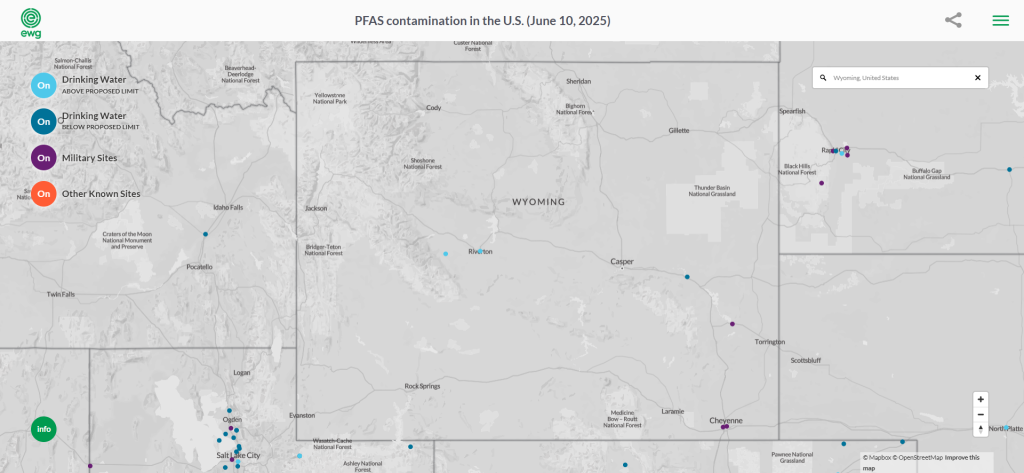- Home
- Personal Injury
- PFAS Lawsuit
- PFAS Contamination Map
- PFAS in Wyoming
PFAS in Wyoming
- Last updated: July 16, 2025
-
Contributor: nicky

I have followed the issue of per- and polyfluoroalkyl substances (PFAS) contamination in Wyoming since early 2024. These persistent chemicals, often called “forever chemicals,” have been found in drinking water supplies, industrial areas, and even Superfund sites across the state. My aim is to present factual information on how PFAS contamination affects Wyoming’s residents, environment, and agriculture, while highlighting the state and federal responses currently underway. In this article, I will also discuss legal considerations, including whether you might qualify for a PFAS-related claim.
What are PFAS and why are they dangerous?
PFAS are synthetic substances first developed in the 1940s that resist high temperatures, oils, water, and corrosion. Their durable chemical bonds make them ubiquitous in many products, from firefighting foam to nonstick cookware. However, that same durability means PFAS do not break down easily in the environment. Evidence compiled by the Centers for Disease Control and Prevention (CDC) shows that PFAS can accumulate in the human body, creating potential risks for kidney, liver, and thyroid health.
High PFAS levels in drinking water have been associated with an increased chance of kidney and testicular cancers, ulcerative colitis, and other conditions. Many public health authorities, including the Environmental Protection Agency (EPA), consider PFAS a serious concern due to their ability to enter the food chain through crops, livestock, and groundwater.
Where are PFAS found in Wyoming?
PFAS first appeared in Wyoming through industrial processes, military bases, and municipal waste facilities. The chemicals can also migrate from firefighting foam (known as aqueous film-forming foam, or AFFF), historically used for training and emergency response at airports and military installations. Over decades, these substances have seeped into soil and groundwater. According to data from the Wyoming Department of Environmental Quality (DEQ), PFAS traces have appeared in multiple counties, often near refineries, bulk storage sites, or areas that once relied on PFAS-rich products.
I have seen reports tying PFAS to contamination at the former Spartan Chemical Superfund Site. Even though historical records do not conclusively show PFAS used at that plant, groundwater sampling in and around the site detected high PFAS concentrations, including 802 parts per trillion (ppt) of PFOS and 42 ppt of PFOA in certain wells. Future sampling is ongoing to confirm the scope of contamination.
PFAS in Wyoming’s drinking water
When PFAS enter drinking water sources, the potential harm extends across entire communities. In Wyoming, officials are monitoring wells, municipal water systems, and surface water to gauge the severity of PFAS contamination. I have observed this issue grow in urgency because public health experts say that even small amounts of PFAS can accumulate in people’s bodies over time.
Known contaminated water systems
Several public water systems in the state have reported PFAS detections. Investigations often center on areas near industrial activities, airports, or military sites. For instance, the Jackson Hole Airport Board joined a lawsuit in June 2024, alleging manufacturers of firefighting foam containing PFAS contributed to local water contamination. This consolidated case involves over 1,200 plaintiffs nationwide, indicating a widespread concern about PFAS in drinking water.
The F.E. Warren Air Force Base in southeastern Wyoming is monitoring PFAS as part of a Department of Defense initiative to assess contamination at military facilities. While data remain under review, historical usage of firefighting foam at these sites suggests possible groundwater migration of PFAS.
Common PFAS sources: AFFF foam, waste facilities, industry
I have come to recognize three major PFAS pathways in Wyoming:
AFFF Foam: Often used at airports and military bases to douse fuel fires.
Waste Facilities: Landfills and other waste sites that disposed of PFAS-rich materials without special handling in past decades.
Industrial Plants: Refineries or chemical operations that once used PFAS for processing or packaging.
These pathways clarify why PFAS turn up in wells, streams, or city water systems, despite the state’s generally low population density.
Water testing efforts by Wyoming DEQ and EPA
The Wyoming DEQ works with the EPA to sample water sources, aiming to identify areas of elevated PFAS. The EPA has set new Maximum Contaminant Levels (MCLs) for certain PFAS, proposing 4 ppt for PFOA and 4 ppt for PFOS. Public water systems will need to comply with these standards by April 2029. In Wyoming, some local authorities have already advised residents to use filters or bottled water when PFAS levels exceed federal or state guidance.
PFAS in Wyoming’s soil and agriculture
While water contamination draws the most attention, PFAS also infiltrate soil. Agricultural lands might be exposed when biosolids or sewage sludge, containing PFAS, are applied as fertilizer. These chemicals can then move from the soil into crops or livestock.
Agricultural risks: Sludge application, crop exposure
I have read data showing that even small amounts of PFAS in sludge or soil amendments can lead to measurable levels of contamination in plants. Because Wyoming has agricultural regions that sometimes use treated sludge for soil enrichment, the risk arises that PFAS could accumulate in corn, wheat, or alfalfa. Continued application over multiple growing seasons might allow these chemicals to build up.
Livestock and groundwater impacts
Livestock can ingest PFAS-contaminated water or feed and then store the chemicals in their tissues. Dairy and beef cattle near industrial or military sites, for instance, might develop PFAS levels that could be passed along in meat or milk. Rural residents who depend on private wells for household water also remain vulnerable. Although the Wyoming DEQ and EPA have begun outreach campaigns, complete data on PFAS in rural wells are still limited.
Health effects of PFAS exposure
I have reviewed multiple studies linking PFAS to adverse health outcomes. The CDC released an update on January 26, 2024, stating there is mounting evidence connecting higher PFAS exposure to an increased risk of kidney cancer. Other documented effects include testicular cancer, thyroid disease, liver disorders, fertility problems, and some autoimmune conditions.
Researchers propose several mechanisms. PFAS may mimic or interfere with hormonal pathways. They might also stress kidney and liver function, as these organs work to filter toxins. Because PFAS persist in the body for years, low-level exposure repeated over time can lead to accumulation. Here are some documented health effects:
Kidney cancer, particularly among older adults.
Testicular cancer, with some studies suggesting a direct correlation to firefighting activities or proximity to PFAS industrial sites.
Thyroid dysfunction, including hypothyroidism.
Liver damage, indicated by elevated liver enzymes.
Possible immune system impairment, leading to decreased vaccine response or other autoimmune risks.
Diseases linked to PFAS in Wyoming
Several diseases receive special attention when discussing PFAS in Wyoming. These include cancers of the kidney, testicles, and liver, alongside disorders of the thyroid. I have also noted a growing dialogue around fertility issues and pregnancy complications. Understanding these risks is vital for anyone living near high-PFAS areas.
Testicular and kidney cancer
Research published over the last decade underscores a statistically significant association between PFAS exposure and testicular cancer. A concern in Wyoming centers on firefighting foam usage, particularly around F.E. Warren Air Force Base and local airports. The CDC’s January 2024 health alert also focused on kidney cancer, stating that increased cases in men and women aged 55 to 74 may reflect chronic exposure to PFAS-contaminated drinking water supplies.
Liver and thyroid disorders
I have encountered data showing that Wyoming has seen an uptick in liver cancer diagnoses, which could be tied to PFAS presence near industrial sites. Additionally, PFAS can disrupt thyroid hormone homeostasis, sometimes resulting in hypothyroidism or other thyroid-related conditions. Continuous monitoring by the Wyoming DEQ, along with county health departments, may help determine if any surge in thyroid disorders correlates directly with PFAS.
Fertility and pregnancy complications
Evidence suggests PFAS may affect fertility, potentially leading to lower birth weights or complications during pregnancy. Scientists propose that PFAS might disrupt endocrine signals, which in turn can affect reproductive functions. While comprehensive state-level data are still in progress, pregnant individuals in areas of known contamination may want to consult healthcare providers about PFAS exposure risks.
Autoimmune and developmental conditions
Studies have explored possible associations between PFAS and autoimmune conditions such as ulcerative colitis. In Wyoming, local health departments and research groups watch for trends in autoimmune and developmental disorders, especially among children exposed to PFAS early in life. Although the overall data remain evolving, caution is advised whenever PFAS levels in water or soil surpass proposed guidelines.
How is Wyoming responding to PFAS contamination?
Wyoming authorities are working to balance local economic interests, such as agriculture and industry, with the urgent need to manage PFAS risks. The state is pursuing multiple strategies, including expanded sampling, improved public outreach, and collaboration with national agencies like the EPA.
Government testing initiatives
The Wyoming DEQ began increasing its PFAS testing in 2022, sometimes partnering with the EPA to inspect municipal systems and private wells near probable contamination sources. Officials indicated plans to adopt future federal PFAS rules fully once the EPA finalizes national standards in the coming years.
Public notifications and community response
Public meetings, fact sheets, and local news alerts have kept residents aware of ongoing sampling results. In Jackson Hole, for example, the decision to join an ongoing lawsuit gained wide media coverage. Community health forums regularly gather input from residents concerned about PFAS in drinking water and farmland. In my view, this public involvement drives accountability among commercial and government entities.
Federal and state collaboration
Agencies such as the EPA, the Department of Defense, and the U.S. Department of Agriculture (USDA) contribute resources or technical assistance. The EPA’s PFAS Roadmap, updated periodically, outlines upcoming regulations that Wyoming must follow. This plan includes investigating discharges from industrial facilities into publicly owned treatment works (POTWs) through nationwide data collection, which can help pinpoint the biggest contributors to PFAS in wastewater.
Can you test your water or soil for PFAS in Wyoming?
I often receive questions on how to confirm the presence of PFAS. The Wyoming DEQ suggests using professional laboratories certified to analyze PFAS to ensure accurate detection. If you have a private well:
Contact state or county environmental offices to see if they offer free or subsidized PFAS testing.
Choose an EPA-approved method (such as EPA Method 537.1) for collecting and testing water samples.
Compare any detected PFAS levels against the proposed federal MCL of 4 ppt for PFOA and PFOS or existing state advisory levels, if any.
For soil testing, commercial labs can measure PFAS concentrations in samples collected from yards, farmland, or near old fire-training sites. If you suspect contamination, I recommend seeking guidance from the DEQ to confirm sampling protocols and interpret results.
Do you qualify for a PFAS lawsuit in Wyoming?
Residents who have experienced health problems or property damage due to PFAS may wonder if they qualify for legal remedies. Lawsuits typically target manufacturing companies or organizations that knowingly mishandled or did not adequately disclose PFAS risks. In 2024, the CDC’s alert on kidney cancer risk and the Jackson Hole Airport Board’s lawsuit have highlighted growing legal activity throughout the state.
Personal injury or property damage claims can hinge on proving:
Documented exposure to PFAS above state or federal guidelines.
A connection between contamination and a diagnosed illness or loss (such as decreased property value).
Evidence that a company, agency, or other party contributed to the contamination through negligence or misconduct.
If you suspect PFAS-related illness or property damage, you may want to consult an attorney specializing in environmental litigation. Additional legal guidance is available at the PFAS Lawsuit page of Legal Claim Assistant.
Moreover, some individuals have pursued lawsuits against large chemical companies (for example, DuPont) alleging PFAS negligence or harm.
Why choose Legal Claim Assistant
I recognize that legal battles involving PFAS can be complex, given the breadth of scientific data and multiple parties often involved. Legal Claim Assistant connects you with attorneys who focus on PFAS matters. These lawyers understand environmental regulations, state statutes, and the nuances of proving PFAS-related damages. The service can help you navigate class actions or individual lawsuits, ensuring your case receives comprehensive evaluation.
You may be eligible for compensation to cover medical bills, property remediation, or other PFAS-related losses. Since PFAS litigation frequently involves major corporations and government agencies, having a dedicated legal resource can be a critical step toward holding polluters accountable. Legal Claim Assistant also provides free case reviews, allowing you to explore your legal options without upfront costs.
Frequently asked questions (FAQ)
Below are some common queries I hear about PFAS contamination in Wyoming, including information on testing, health impacts, and legal eligibility.
PFAS contamination has been documented around Shepherd Field Air National Guard Base in Berkeley County, in northern counties with oil and gas operations, and near older manufacturing facilities. Martinsburg is among the most high-profile cases, where the Big Springs Well was offline for treatment in 2016 because of PFOS contamination.
Yes. You can contact certified laboratories recommended by the WVDEP or your local health department. They can provide sampling instructions and ensure accurate test results. Make sure you follow all suggestions about container sterilization and sample handling to avoid unintentionally contaminating the sample.
The PFAS Protection Act (HB 3189) empowers the WVDEP to detect and mitigate PFAS sources by requiring more stringent reporting and water treatment protocols. Additional federal funding supports the replacement or enhancement of filtration systems, especially in communities where contamination levels exceed the EPA’s proposed 4 parts per trillion limit for PFOA and PFOS.
While PFAS can enter soil and water, West Virginia has not reported large-scale contamination in agricultural products. However, testing continues, particularly where PFAS levels in groundwater or surface water appear elevated. Farmers and consumers are encouraged to stay updated on results from ongoing WVDEP and DHHR monitoring programs.
Extensive studies have connected PFAS exposure to kidney cancer, testicular cancer, thyroid disease, high cholesterol, and possible immune system disruptions. The evidence continues to grow, with more data emerging on how PFAS behave in the human body over time.
You may be able to file a lawsuit if you can demonstrate that PFAS from a specific source caused or contributed to your illness or property harm. Each situation is different, so the best approach is to consult a specialized PFAS attorney. Resources like Legal Claim Assistant can help by connecting you to legal experts for a free case review.
Whether you are testing your well or worrying about possible exposures, you do not have to face PFAS contamination alone. By staying informed and seeking professional guidance, you can protect yourself and your family while supporting broader efforts to reduce contamination throughout West Virginia. If you want to learn how PFAS contamination compares in other regions, you can explore resources like in Virginia and Georgia.
Overview PFAS contamination in the USA
Here you van find the PFAS watercontamination map of the United States. Find, state by state, where water contamination has occurred due to PFAS exposure.
- PFAS in Alabama
- PFAS in Alaska
- PFAS in Arizona
- PFAS in Arkansas
- PFAS in California
- PFAS in Colorado
- PFAS in Connecticut
- PFAS in Delaware
- PFAS in Florida
- PFAS in Georgia
- PFAS in Hawaii
- PFAS in Idaho
- PFAS in Illinois
- PFAS in Indiana
- PFAS in Iowa
- PFAS in Kansas
- PFAS in Kentucky
- PFAS in Louisiana
- PFAS in Maine
- PFAS in Maryland
- PFAS in Massachusetts
- PFAS in Michigan
- PFAS in Minnesota
- PFAS in Mississippi
- PFAS in Missouri
- PFAS in Montana
- PFAS in Nebraska
- PFAS in Nevada
- PFAS in New Hampshire
- PFAS in New Jersey
- PFAS in New Mexico
- PFAS in New York
- PFAS in North Carolina
- PFAS in North Dakota
- PFAS in Ohio
- PFAS in Oklahoma
- PFAS in Oregon
- PFAS in Pennsylvania
- PFAS in Rhode Island
- PFAS in South Carolina
- PFAS in South Dakota
- PFAS in Tennessee
- PFAS in Texas
- PFAS in Utah
- PFAS in Vermont
- PFAS in Virginia
- PFAS in Washington
- PFAS in West Virginia
- PFAS in Wisconsin
- PFAS in Wyoming
Related Article

What Philips CPAP Machines Are Recalled and Why

